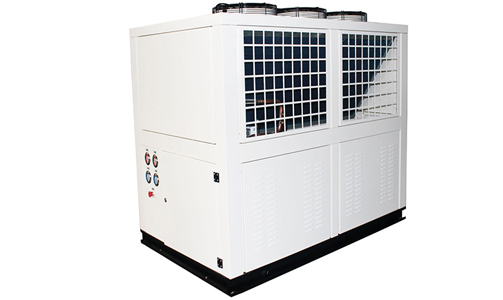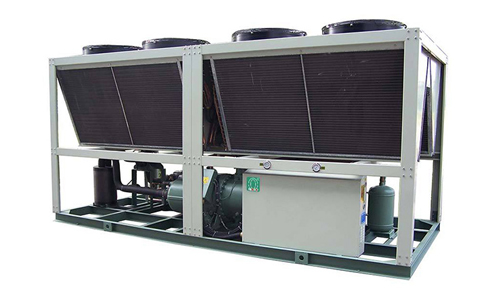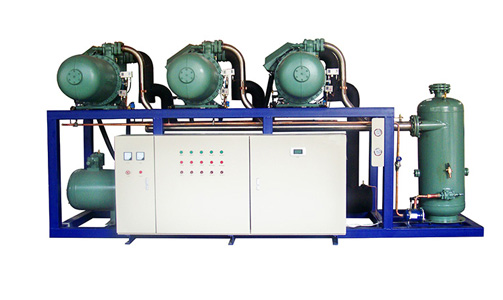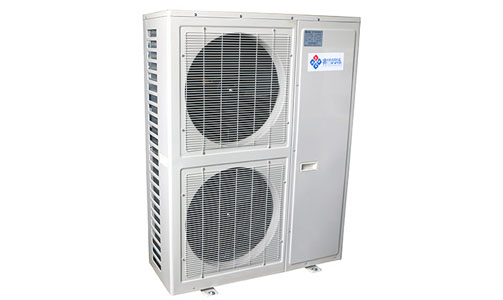Before you buy an air-cooled chiller, make sure you know what the term "air-cooled chiller" means.
Scroll compressor technology reduces energy consumption and increases the reliability of air-cooled and water-cooled chillers.
Like all chillers, air-cooled chillers require cooling - the term "air-cooled" refers only to how the chiller dissipates heat. Air-cooled chillers transfer heat from one medium to another by using the surrounding air to cool a finned-tube refrigerant-to-air heat exchanger. For example, consider a plastic injection molding machine. The hot plastic in the mold transfers heat to the process water. The process water then transfers the heat to the refrigerant, which distributes the heat to the surrounding air.
Indoor and outdoor air-cooled chillers
The design of air-cooled chillers varies depending on where the equipment is used. Some chillers are designed for outdoor or indoor applications. Other air-cooled designs, called split systems, allow for the cooling portion of the unit to be installed indoors and the hot air discharge portion or condenser to be installed outdoors.
When considering your options, keep in mind that air-cooled chillers generate more heat than they absorb. The total heat discharge is equal to the heat discharge rating of the chiller plus the electrical input of the compressor. If you are using an air-cooled chiller indoors, the room in which the chiller is installed must be well ventilated, have adequate operating space, and a consistent ambient temperature of 65 to 95°F (18 to 35°C). If the room in which the chiller is installed is poorly ventilated, has limited operating space, or is air-conditioned, the chiller should be installed outdoors or in a split system. Installing the cooling section indoors and the condenser outdoors has several advantages over installing the entire chiller outdoors. They include.

Box Type Air-cooled Chiller
Smaller space requirements. Without the air-cooled section, the chiller's footprint is much smaller.
Lower service costs. By placing the cooling section indoors, the unit is much easier to service.
Lower operating costs. Split systems installed in northern climates do not require antifreeze if the process water temperature is above 48°F (9°C).
Air-cooled chillers can operate year-round in a variety of climates.
Outdoor air-cooled chillers
For any chiller application, understand the chiller's operating limitations. Process cooling chillers must be able to operate at temperatures of -20°F (-29°C) in northern climates and 0°F (-18°C) in southern climates. These design constraints distinguish HVAC units from process cooling coolers: HVAC coolers do not typically operate at temperatures below 32°F (0°C), while process cooling coolers are expected to operate at a variety of temperatures year-round.
Process cooling coolers offer a separate baffled air section with horizontally mounted coils that prevent cold air from blowing through the unit. This design prevents air from being drawn through the fan that has been cycled off and helps maintain consistent cooling pressure. For temperatures below 0°F, this design will also adjust the speed of the last fan motor based on refrigerant pressure. This allows the chiller to operate at temperatures below 0°F.
When selecting an outdoor air-cooled chiller, look for a design that is less prone to refrigerant leakage. Refrigerant leaks are the primary cause of chiller shutdowns. Air-cooled heat exchangers use copper tubes that are mechanically expanded into aluminum fins and tube plates. Often, leaks form in the tube plates that support the weight of the heat exchanger. A design was sought that would not expand the refrigeration tubes into the tube plates. This design uses a blind tube or non-refrigerant tube to support it through the tube plate. The copper tube that circulates the refrigerant passes through a hole in the tube plate that is larger than the tube, thus eliminating any chance of wear caused by vibration.

Air-cooled Screw Chillers
Remember that the compressor or pump that delivers and compresses the refrigerant is the heart of the chiller. Chillers that use rotary technology compressors have a lower probability of failure. These rotary technology units are called scroll or screw compressors and have no connecting rods, pistons, or valves. Screw compressors are used above 40 hp, while scroll compressors are used below 30 hp.
Indoor air-cooled chillers
Look for indoor air-cooled chillers with washable, reusable filters. Plastic dust typically found in plastic molding environments can be drawn into the chiller's air intake, reducing cooling efficiency. This will eventually shut down the chiller if left unattended.
Simply cleaning the filter can save money and is cheaper than cleaning the finned tube heat exchanger. Also, look for units with variable speed fan motors. An exhaust fan controlled by a variable speed drive will vary the fan speed depending on the ambient air temperature and process heat load. Since chillers rarely run at full load, a variable speed drive will reduce the fan speed, thus reducing energy consumption and noise levels.
How the waste heat is discharged is another consideration. If you choose to duct chiller discharge air throughout the plant, make sure the chiller fan can provide enough static air pressure to overcome frictional losses caused by ductwork.
Accurate control of the discharge water temperature is critical. Look for chillers that use off-the-shelf PID temperature controllers. This type of controller provides an auto-tuning feature that allows you to customize the control to your process. Proprietary controls do not offer this feature. As with outdoor chillers, the compressor is the heart of the indoor chiller, and rotary compressor technology offers the same benefits.
Finally, keep in mind that rust in the system can impede heat transfer and lead to costly repairs. Consider using a chiller with a non-ferrous water circuit. Pump tanks, pumps, evaporators (refrigerant-to-water heat exchangers), piping, valves, and fittings should be made of non-ferrous materials such as brass, stainless steel, rubber, or plastic.
Knowledge is key when purchasing any type of equipment. These tips on indoor and outdoor air-cooled chillers will help ensure that the next air-cooled chiller you purchase will be the right chiller for your situation.










